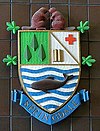Springdale, Newfoundland and Labrador
|
Springdale Wolf Cove |
||
|---|---|---|
| Town | ||
|
||
| Location of Springdale in Newfoundland | ||
| Coordinates: 49°29′N 56°06′W / 49.483°N 56.100°W | ||
| Country |
|
|
| Province |
|
|
| Settled | 1877 | |
| Government | ||
| Area | ||
| • Urban | 17.60 km2 (6.80 sq mi) | |
| Population (2016) | ||
| • Town | 2,971 | |
| Time zone | Newfoundland Time (UTC-3:30) | |
| • Summer (DST) | Newfoundland Daylight (UTC-2:30) | |
| Area code(s) | 709 | |
| Website | Springdale official site | |
Springdale is a town in Newfoundland and Labrador, Canada, which had a population of 2,764 in the Canada 2006 Census. The community is located on the Northwestern shores of Hall's Bay, in Central Newfoundland, near the mouth of Indian River. Hall's Bay takes its name from an ill-fated ship captain who, along with his crew, was killed and decapitated by a group of Beothuk in the mid-18th century. According to local lore, the heads of Captain Hall and his crewmen were found on top of wooden pikes stuck in the ground along the coast of the bay. Like most communities in this region, Springdale is home to many legends centred on the Beothuck people.
This small town hosts the Springdale Braves (male) and the Springdale Bravettes (female) hockey teams. They also host the Springdale Bluefins swim team. The town has a small harbour, a hospital, and many recreational facilities, including a hockey rink, curling club, tennis courts, a soccer pitch and softball field. Springdale is known as the "hub" of Green Bay, and provides services to a number of communities in the Green Bay North and Green Bay South areas. The town boasts a number of chain restaurants, including Mary Brown's, Subway, Tim Hortons, and Greco Express, in addition to locally owned ventures such as Marie's Restaurant, Kaitlyn's Restaurant, and Bojo's Restaurant.
Springdale has two schools; Indian River Academy, which houses students from Kindergarten to Grade 6, and Indian River High School, which serves students in Grades 7 through 12
On the outskirts of town is Glassy Beach, which is known for being covered in smooth pieces of broken glass that you can safely walk across in your bare feet.
The Springdale area was first inhabited by aboriginal peoples, including the Beothuk and Mi'kmaq, and there is evidence to suggest that the Dorset and Maritime Archaic Indians also spent time there.
The first recorded European settler was Nicholas Peters who, in 1877, constructed a sawmill on Mill Island, near the mouth of Indian River, and approximately 200 metres off the shore of present-day Springdale. There are several families living in Springdale today who are his direct descendants (with the surnames of Peters or Young), some of whom live on 'Peters Lane'. This sawmill attracted other settlers, and buildings were soon constructed on the "mainland," across from Mill Island, in a sheltered area called Wolf Cove. In fact, "Wolf Cove" remained the name of the settlement for a number of years. The sawmill was eventually sold to the Curtis Brothers of Twillingate, and was destroyed by fire in 1890. After the blaze, settlers ceased to live on Mill Island, and moved to Wolf Cove.
...
Wikipedia


